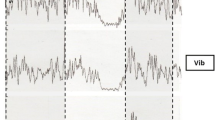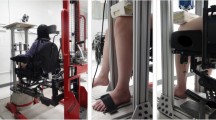Abstract
Suppression of an ongoing muscle contraction following noxious digital stimulation is called cutaneous silent period (CSP) which is under the influence of several physiological factors. In this study, we aimed to evaluate the influence of group Ia afferents on the cutaneous silent period (CSP) by applying 2-min vibration. CSP was obtained from abductor pollicis brevis muscle after stimulating index finger. The recordings were repeated three times—before, during and after vibration—which was applied over the tendon of flexor carpi radialis muscle. Onset latency, duration and magnitude of total CSP, inhibitory phases I1 and I2, and of the long-loop reflex were measured and compared. Suppression indices of CSP, I1 and I2 increased significantly during and after vibration, indicating significantly less exteroceptive EMG suppression outlasting the time of vibration. Vibration also caused mild shortening of I2 end latency (p = 0.048) and I2 duration (p = 0.019). Our findings indicate that vibration exerts a powerful influence on CSPs and causes reduction in the magnitude of exteroceptive EMG suppression during and after vibration. Although vibration is known to activate Ia afferents, we cannot exclude contribution of other afferents, e.g. mechanoreceptors, as well as pre- or postsynaptic inhibitory effects on ensuing interneurons, or enhanced vibration-related excitatory influence.


Similar content being viewed by others
References
Claus D, Mills KR, Murray NM (1988) The influence of vibration on the excitability of alpha motoneurones. Electroencephalogr Clin Neurophysiol 69:431–436
Ertekin C, Akçali D (1978) Effect of continuous vibration on nociceptive flexor reflexes. J Neurol Neurosurg Psychiatry 41:532–537
Fallon JB, Macefield VG (2007) Vibration sensitivity of human muscle spindles and Golgi tendon organs. Muscle Nerve 36:21–29
Fetz EE, Jankowska E, Johannisson T, Lipski J (1979) Autogenetic inhibition of motoneurons by impulses in group Ia muscle spindle afferents. J Physiol 293:173–195
Friedel T (1999) The vibrational startle response of the desert locust Schistocerca gregaria. J Exp Biol 202:2151–2159
Gilio F, Bettolo CM, Conte A, Iacovelli E, Frasca V, Serrao M, Giacomelli E, Gabriele M, Prencipe M, Inghilleri M (2008) Influence of the corticospinal tract on the cutaneous silent period: a study in patients with pyramidal syndrome. Neurosci Lett 433:109–113
Gillies JD, Lance JW, Neilson PD, Tassinari CA (1969) Presynaptic inhibition of the monosynaptic reflex by vibration. J Physiol 205:329–339
Griffin L, Garland SJ, Ivanova T, Gossen ER (2001) Muscle vibration sustains motor unit firing rate during submaximal isometric fatigue in humans. J Physiol 535:929–936
Hill BD, Blumenthal TD (2005) Inhibition of acoustic startle using different mechanoreceptive channels. Percept Psychophys 67:741–747
Hollins M, McDermott K, Harper D (2014) How does vibration reduce pain? Perception 43:70–84
Hultborn H (2001) State-dependent modulation of sensory feedback. J Physiol 533:5–13
Illert M, Kümmel H (1999) Reflex pathways from large muscle spindle afferents and recurrent axon collaterals to motoneurones of wrist and digit muscles: a comparison in cats, monkeys and humans. Exp Brain Res 128:13–19
Illert M, Wietelmann D (1989) Distribution of recurrent inhibition in the cat forelimb. In: Allum JHJ, Hulliger M (eds) Prog Brain Res. Elsevier, Amsterdam, pp 273–281
Inghilleri M, Cruccu G, Argenta M, Polidori L, Manfredi M (1997) Silent period in upper limb muscles after noxious cutaneous stimulation in man. Electroencephalogr Clin Neurophysiol 105:109–115
Inghilleri M, Conte A, Frasca V, Berardelli A, Manfredi M, Cruccu G (2002) Is the cutaneous silent period an opiate-sensitive nociceptive reflex? Muscle Nerve 25:695–699
Johnson MT, Mendez A, Kipnis AN, Silverstein P, Zwiebel F, Ebner TJ (1994) Acute effects of levodopa on wrist movement in Parkinson’s disease. Kinematics, volitional EMG modulation and reflex amplitude modulation. Brain 117:1409–1422
Katz R, Mazzocchio R, Pénicaud A, Rossi A (1993) Distribution of recurrent inhibition in the human upper limb. Acta Physiol Scand 149:183–198
Kimura J (2006) Electrodiagnosis in diseases of nerve and muscle. Principles and practice. Oxford University Press, New York
Kofler M (2003) Functional organization of exteroceptive inhibition following nociceptive electrical fingertip stimulation in humans. Clin Neurophysiol 114:973–980
Kofler M (2004) Influence of transcutaneous electrical nerve stimulation on cutaneous silent periods in humans. Neurosci Lett 360:69–72
Kofler M, Poustka K (2005) Ipsi- and contralateral exteroceptive EMG modulation in uniand bilaterally activated thenar muscles. Clin Neurophysiol 116:300–307
Kofler M, Kumru H, Stetkarova I, Schindler C, Fuhr P (2007) Muscle force up to 50% of maximum does not affect cutaneous silent periods in thenar muscles. Clin Neurophysiol 118:2025–2030
Kofler M, Kumru H, Stetkarova I, Rüegg S, Fuhr P, Leis AA (2009) Cutaneous silent periods are not affected by the antihistaminic drug cetirizine. Clin Neurophysiol 120:1016–1019
Kofler M, Valls-Solé J, Vasko P, Boček V, Štetkárová I (2014) Influence of limb temperature on cutaneous silent periods. Clin Neurophysiol 125:1826–1833
Kumru H, Opisso E, Valls-Solé J, Kofler M (2009) The effect of a prepulse stimulus on the EMG rebound following the cutaneous silent period. J Physiol 587:587–595
Leis AA (1998) Cutaneous silent period. Muscle Nerve 21:1243–1245
Leis AA, Stĕtkárová I, Berić A, Stokić DS (1995) Spinal motor neuron excitability during the cutaneous silent period. Muscle Nerve 18:1464–1470
Lopergolo D, Isak B, Gabriele M, Onesti E, Ceccanti M, Capua G, Fionda L, Biasiotta A, Di Stefano G, La Cesa S, Frasca V, Inghilleri M (2015) Cutaneous silent period recordings in demyelinating and axonal polyneuropathies. Clin Neurophysiol 126:1780–1789
Manconi FM, Syed NA, Floeter MK (1998) Mechanisms underlying spinal motor neuron excitability during the cutaneous silent period in humans. Muscle Nerve 21:1256–1264
Melzack R, Wall PD (1965) Pain mechanisms: a new theory. Science 150:971–979
Mosier EM, Herda TJ, Trevino MA, Miller JD (2017) The influence of prolonged vibration on motor unit behavior. Muscle Nerve 55:500–507
Mota IA, Fernandes JB, Cardoso MN, Sala-Blanch X, Kofler M, Valls-Solé J (2015) Temporal profile of the effects of regional anesthesia on the cutaneous reflexes of foot muscles. Exp Brain Res 233:2587–2596
Park KW, Boyer MI, Calfee RP, Goldfarb CA, Osei DA (2014) The efficacy of 95-Hz topical vibration in pain reduction for trigger finger injection: a placebo-controlled, prospective, randomized trial. J Hand Surg Am 39:2203–2207
Pazzaglia C, Camerota F, Celletti C, Minciotti I, Testani E, Padua L, Valeriani M (2017) Focal mechanical vibration does not change laser-pain perception and laser-evoked potentials: a pilot study. Pain Pract 17:25–31
Pierrot-Deseilligny E, Burke D (2012) The circuitry of the human spinal cord. Spinal and corticospinal mechanisms of movement. Cambridge University Press, Cambridge
Priori A, Berardelli A, Inghilleri M, Pedace F, Giovannelli M, Manfredi M (1998) Electrical stimulation over muscle tendons in humans—evidence favouring presynaptic inhibition of Ia fibres due to the activation of group III tendon afferents. Brain 121:373–380
Pujia F, Coppola G, Anastasio MG, Brienza M, Vestrini E, Valente GO, Parisi L, Serrao M, Pierelli F (2012) Cutaneous silent period in hand muscles is lengthened by tramadol: evidence for monoaminergic modulation? Neurosci Lett 528:78–82
Pujia F, Serrao M, Brienza M, Vestrini E, Valente GO, Coppola G, Pierelli F (2014) Effects of a selective serotonin reuptake inhibitor escitalopram on the cutaneous silent period: a randomized controlled study in healthy volunteers. Neurosci Lett 566:17–20
Rodi Z, Springer C (2011) Influence of muscle contraction and intensity of stimulation on the cutaneous silent period. Muscle Nerve 43:324–328
Rosenkranz K, Rothwell JC (2003) Differential effect of muscle vibration on intracortical inhibitory circuits in humans. J Physiol 551:649–660
Serrao M, Parisi L, Pierelli F, Rossi P (2001) Cutaneous afferents mediating the cutaneous silent period in the upper limbs: evidences for a role of low-threshold sensory fibres. Clin Neurophysiol 112:2007–2014
Serrao M, Parisi L, Valente G, Martini A, Fattapposta F, Pierelli F, Rossi P (2002) L-dopa decreases cutaneous nociceptive inhibition of motor activity in parkinson’s disease. Acta Neurol Scand 105:196–201
Stetkarova I, Kofler M (2013) Differential effect of baclofen on cortical and spinal inhibitory circuits. Clin Neurophysiol 124:339–345
Stetkarova I, Kofler M, Majerova V (2015) Cutaneous silent periods in multiple system atrophy. Biomed Pap Med Fac Univ Palacky Olomouc Czech Repub 159:327–332
Syrovegin AV, Kukushkin ML, Gnezdilov AV, Ovechkin AM, Li TS (2000) EMG responses in humans during painful heterosegmentary stimulation. Bull Exp Biol Med 130:1069–1073
Uncini A, Kujirai T, Gluck B, Pullman S (1991) Silent period induced by cutaneous stimulation. Electroencephalogr Clin Neurophysiol 81:344–352
Weerakkody NS, Percival P, Hickey MW, Morgan DL, Gregory JE, Canny BJ, Proske U (2003) Effects of local pressure and vibration on muscle pain from eccentric exercise and hypertonic saline. Pain 105:425–435
Xu L, Negro F, Xu Y, Rabotti C, Schep G, Farina D, Mischi M (2018) Does vibration superimposed on low-level isometric contraction alter motor unit recruitment strategy? J Neural Eng 15:066001
Acknowledgements
All authors wish to thank all the volunteers who agreed to participate in the study.
Funding
None.
Author information
Authors and Affiliations
Corresponding author
Ethics declarations
Conflict of interest
The authors declare that they have no conflict of interest.
Ethical approval
We confirm that we have read the Journal’s position on issues involved in ethical publication and affirm that this report is consistent with those guidelines.
Additional information
Publisher’s Note
Springer Nature remains neutral with regard to jurisdictional claims in published maps and institutional affiliations.
Rights and permissions
About this article
Cite this article
Aydın, Ş., Kofler, M., Bakuy, Y. et al. Effects of vibration on cutaneous silent period. Exp Brain Res 237, 911–918 (2019). https://doi.org/10.1007/s00221-018-05463-1
Received:
Accepted:
Published:
Issue Date:
DOI: https://doi.org/10.1007/s00221-018-05463-1




